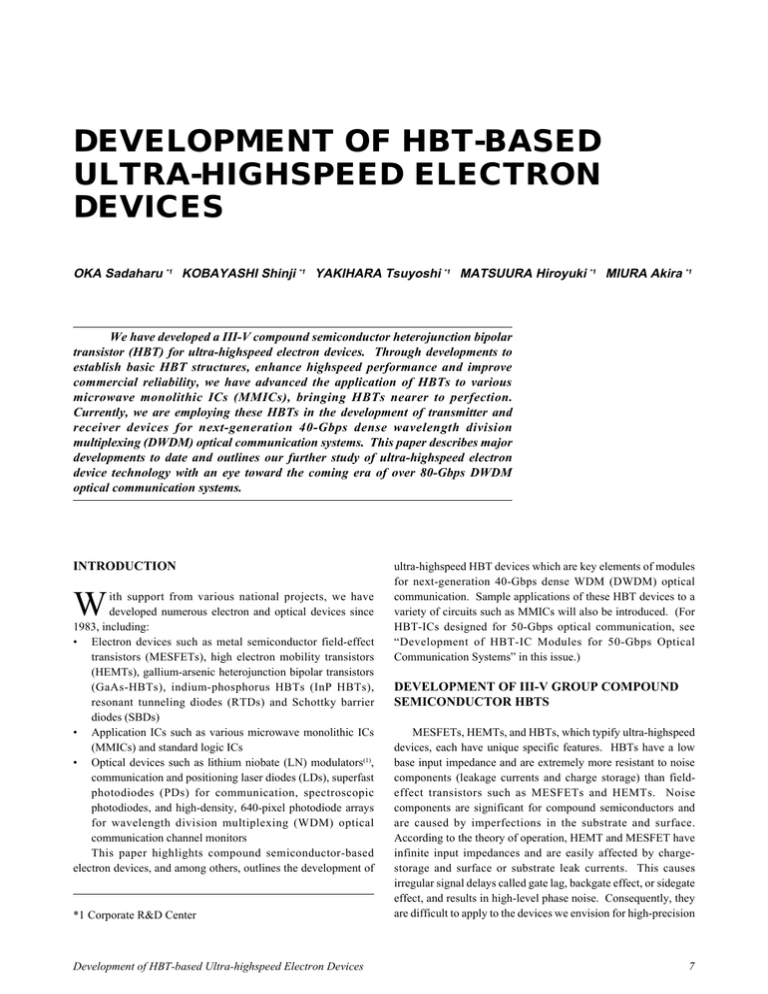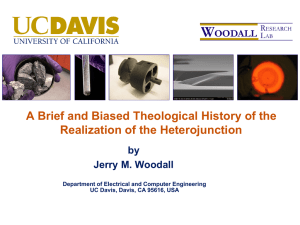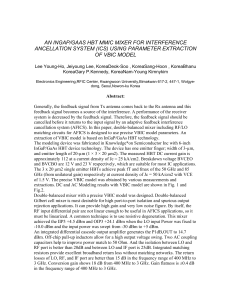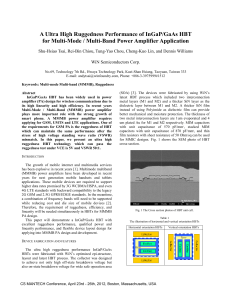development of hbt-based ultra-highspeed electron
advertisement

DEVELOPMENT OF HBT-BASED ULTRA-HIGHSPEED ELECTRON DEVICES OKA Sadaharu *1 KOBAYASHI Shinji *1 YAKIHARA Tsuyoshi *1 MATSUURA Hiroyuki *1 MIURA Akira *1 We have developed a III-V compound semiconductor heterojunction bipolar transistor (HBT) for ultra-highspeed electron devices. Through developments to establish basic HBT structures, enhance highspeed performance and improve commercial reliability, we have advanced the application of HBTs to various microwave monolithic ICs (MMICs), bringing HBTs nearer to perfection. Currently, we are employing these HBTs in the development of transmitter and receiver devices for next-generation 40-Gbps dense wavelength division multiplexing (DWDM) optical communication systems. This paper describes major developments to date and outlines our further study of ultra-highspeed electron device technology with an eye toward the coming era of over 80-Gbps DWDM optical communication systems. INTRODUCTION W ith support from various national projects, we have developed numerous electron and optical devices since 1983, including: • Electron devices such as metal semiconductor field-effect transistors (MESFETs), high electron mobility transistors (HEMTs), gallium-arsenic heterojunction bipolar transistors (GaAs-HBTs), indium-phosphorus HBTs (InP HBTs), resonant tunneling diodes (RTDs) and Schottky barrier diodes (SBDs) • Application ICs such as various microwave monolithic ICs (MMICs) and standard logic ICs • Optical devices such as lithium niobate (LN) modulators(1), communication and positioning laser diodes (LDs), superfast photodiodes (PDs) for communication, spectroscopic photodiodes, and high-density, 640-pixel photodiode arrays for wavelength division multiplexing (WDM) optical communication channel monitors This paper highlights compound semiconductor-based electron devices, and among others, outlines the development of *1 Corporate R&D Center Development of HBT-based Ultra-highspeed Electron Devices ultra-highspeed HBT devices which are key elements of modules for next-generation 40-Gbps dense WDM (DWDM) optical communication. Sample applications of these HBT devices to a variety of circuits such as MMICs will also be introduced. (For HBT-ICs designed for 50-Gbps optical communication, see “Development of HBT-IC Modules for 50-Gbps Optical Communication Systems” in this issue.) DEVELOPMENT OF III-V GROUP COMPOUND SEMICONDUCTOR HBTS MESFETs, HEMTs, and HBTs, which typify ultra-highspeed devices, each have unique specific features. HBTs have a low base input impedance and are extremely more resistant to noise components (leakage currents and charge storage) than fieldeffect transistors such as MESFETs and HEMTs. Noise components are significant for compound semiconductors and are caused by imperfections in the substrate and surface. According to the theory of operation, HEMT and MESFET have infinite input impedances and are easily affected by chargestorage and surface or substrate leak currents. This causes irregular signal delays called gate lag, backgate effect, or sidegate effect, and results in high-level phase noise. Consequently, they are difficult to apply to the devices we envision for high-precision 7 Figure 1 Static Characteristics of InP-RTD (5 × 5 µm; Vertical Axis: 5 mA/div.; Horizontal Axis: 0.5 V/div.) Figure 2 Static Characteristics of InP-RBT (100-µA Base Step) measurement and ultra-highspeed communication (devices designed to be applicable to a wide frequency band including the DC region). Thus, we have chosen to concentrate our research and development on HBTs, which are unrivaled in terms of stability and noise resistance. To be more specific, we have been focusing on the research and development of devices having a vertical structure and imperviousness to imperfections in the substrate and defects in the surface since 1988. With potential applications in view for future superfast digital applications, during our development of devices for ultra-highspeed measurement we also embarked on the research and development of vertical-structure devices employing RTDs and HBTs. An RTD is a compound semiconductor device which has an energy band designed to form a quantum well which causes the tunneling effect of electrons, thus functioning as a negativeresistance switching device. Using the quantum-electrodynamic resonance effect, an RTD exhibits such outstandingly fast switching that a digital IC chip to the order of 100 Gbps can be realized, depending, on a design of full-width at half the maximum resonance level. Figure 1 shows the static characteristics of an RTD. This RTD has an InGaAs /AlAs (~1.5 nm)/InGaAs (~3 nm)/ AlAs (~1.5 nm)/InGaAs quantum well structure, formed on an indium-phosphorus (InP) substrate. With a lowered doping concentration for the anode-side InGaAs, its switching voltage is raised to 1.5 Vpp. Employing this RTD, we have already succeeded in actualizing an ultra-highspeed sampling IC that demonstrates high power and a switching speed of several picoseconds.(2) In terms of reliability, this RTD underwent an accelerated high-temperature bias endurance test, and has been proven to be reliable to the level required for measurement applications. Further, we developed an InP resonant tunneling bipolar transistor (InP-RBT) by wedding this RTD and an InP-HBT which was being developed concurrently(3), thereby realizing a three-terminal device useful for application to circuits. Figure 2 shows the static characteristics of this RBT. We anticipate that the use of the aforesaid technologies will serve to realize ultra-highspeed quantum-effect digital ICs combining RTDs and HBTs for application to super ultra- 8 highspeed communication (~100 Gbps). Accordingly, we are conducting studies of the application of these technologies to 80Gbps optical communication systems, which are anticipated to follow the next-generation systems. III-V compound semiconductor HBTs are principally divided into two types: GaAs-based HBTs and InP-based HBTs. Each is distinctive; however, in short, GaAs-based HBTs are superb in breakdown voltage characteristics and InP-based HBTs are excellent in high-speed performance. We advanced their development while capitalizing on the pros and cons of each type, and in 1992, we established the basic structures of GaAs-HBTs and InP-HBTs.(4) SPEED- AND RELIABILITY-ENHANCEMENTS FOR HBTS After establishing the basic structures of GaAs-HBTs and InP-HBTs, we addressed enhancements in reliability, as well as in speed, from the viewpoint of commercialization. While AlGaAsand GaAs-HBTs were previously in the mainstream of research, our GaAs-HBT exhibited a top-level high-speed performance (current gain cutoff frequency f T = 130 GHz; maximum oscillation frequency fmax = 230 GHz) among those of its kind. For AlGaAs-HBTs, however, it was discovered during the development for speed-enhancement that its life is short when Boundary between emitter-base junction and ledge within single crystal Emitter metal InGaP emitter also serving as passivation (ledge) Ledge Intrinsic emitter portion 30 nm 0.4 µm InGaP 30 nm Figure 3 Transmission Electron Microscope (TEM) Image of Emitter-base Junction in InGaP Ledge Structure Yokogawa Technical Report English Edition, No. 34 (2002) Vce = 3.5 V Jc = 50 kA/cm2 Ta = 125°C 40 Normalized hFE % 45 1 × 5 µm emitter 35 Gu 160 120 80 40 0 0 1000 2000 3000 4000 25 20 5000 6000 time (hours) 7000 8000 9000 10000 9000 10000 Vce = 2 V Jc = 100 (typeA) & 75 (typeB) kA/cm2 Ta = 125°C h21 15 ft = 190 GHz 10 fmax = 300 GHz 5 Normalized hFE % h21, Gu (dB) 30 200 120 100 80 60 40 20 0 0 1000 2000 3000 4000 5000 6000 7000 8000 time (hours) 0 1 10 100 1000 Frequency (GHz) Figure 5 High-temperature Bias Endurance Test (Upper: GaAs HBT; Lower: InP HBT) Figure 4 High Frequency Characteristics of Our GaAs-based HBTs used in the high current region. To determine the cause of this, the device underwent a high-temperature endurance test, and cross-sectional, transmission electron microscope (TEM) images of the deteriorated device were analyzed. This revealed that a portion of the crystal lattice on the base-emitter junction had been destroyed. While analyzing this phenomenon and tackling the improvement of reliability, we made a number of refinements including a change of the emitter material to InGaP and the adoption of a ledge structure to the junction so as not to expose the junction on the crystal’s surface (see Figure 3). This improved device is currently undergoing an accelerated hightemperature bias endurance test with the collector current density Jc set at 50 kA/cm2, junction temperature at 200°C, ambient temperature at 125°C, and collector voltage Vce at 3.5 V. It has yet to show any signs of breakdown of life expectancy, and 10,000 hours have elapsed. In further developments, we attempted to enhance speeds of InGaP-HBTs which were already sufficiently reliable for commercialization, and achieved ultrahigh performances of fT = 190 GHz and fmax = 300 GHz (see Figure 4). In addition, we are tackling the development of InP-HBTs to pursue further speed-enhancements. With regard to reliability, two types of InP-HBTs (types A and B) are currently undergoing a high-temperature bias endurance test (with Jc set at 100 kA/cm2 for type A and 75 kA/cm2 for type B). To date, after more than 10000 hours have elapsed for type A and more than 9900 hours for type B, neither shows any signs of breakdown of life expectancy (see Figure 5). By calculating the life expectancy with the acceleration factor set to 25 in assumption of a worst case scenario, we ascertain a useful life of 25 years or longer for our GaAs-HBT and our InPHBT, in use under normal working temperatures. APPLICATION TO MMIC FOR MEASUREMENT AND A/D CONVERTER Our development efforts have also encompassed application of HBTs, which feature excellent high-speed performance, to Development of HBT-based Ultra-highspeed Electron Devices MMICs for measurement and A/D converters. By optimizing the materials and structure of HBTs during the development of MMICs for measurement, we have already succeeded in prototyping an MMIC fundamental oscillator that generates 134 to 146.7 GHz output, which is the world highest frequency of output for a bipolar transistor.(5) Further, taking future applications to frequencies to the order of 100 GHz into account, we studied power enhancements for voltage-controlled oscillators (VCOs). Since the highest possible oscillating output of a VCO employing only one transistor was limited to –3 dBm at 100 GHz, we integrated multiple VCOs into an MMIC, synchronized them for power synthesis, and successfully obtained a practical output. To be more specific, we obtained a +3 dBm output from an MMIC in which four VCOs were integrated. A photograph of this chip is shown in Figure 6. The output of +3 dBm corresponds to the output voltage of approximately 0.9 Vpp with a 50-ohm load. Even though a VCO for a frequency range of 100 GHz was traditionally produced as a three-dimensional circuit with special diodes, this new technology was attained using planar technology techniques, thus having remarkably great significance in both technical and commercial aspects. Namely, the implementation of clock signal generation and the like in chip form for the anticipated subsequent 80-Gbps optical communication systems has been technically achieved. Moreover, the combination with an aircore coil, which is described later, will allow for an even more First-stage oscillator Second-stage oscillator HBTs Output photodiode Power supply photodiodes Third-stage oscillator Final-stage oscillator Chip size: 2.3 × 0.8 mm Figure 6 Quadruple Power Combined 100-GHz MMIC VCO 9 Phase noise [dBc/Hz at 1 MHz offset] -50 FET Yokogawa's HBT -60 -70 -80 This work -90 -100 20 dB -110 Yokogawa's HBT HBT FET -120 -130 0 50 100 150 Frequency [GHz] 200 Figure 7 SSB Noise-frequency Characteristics of 100-146.7 GHz MMIC Oscillator (Quoted from IEEE MTT-S Digest, GaAs IC Symposium Tech. Digest, J. Solid-State Cir.) compact size and higher performance. Figure 7 shows the single-sideband (SSB) noise characteristics of our prototyped 100-146.7 GHz MMIC oscillator. As seen in the figure, Yokogawa’s GaAs-HBT demonstrated noise characteristics superior by approximately 20 dB to those of field-effect transistors such as HEMTs. These lownoise characteristics are exactly what we initially expected of HBT devices, and they demonstrate the overwhelming superiority of HBT’s time-axis (jitter) characteristic for use in devices for communication or measurement in comparison to field-effect transistors. The passive circuit elements required for future ICs operating at a frequency range of 100 GHz and in the bit rate range of 100 Gbps, include capacitors, coils, and resistors. Capacitors and resistors can relatively easily be integrated into an IC as metalinsulator-metal (MIM) capacitors and thin film resistors, respectively. Generally, the only means of integrating coils into an IC, however, is to use the inductance of a distributed-constant circuit, the conditions of which are restricted due to leakage of the electromagnetic field and dielectric losses. From 1988 through 1990, we conducted engineering development of air-core coils which are ideal coils for ICs and hybrid integrated circuits (HICs). Actualized air-core coils, which can be integrated into an 5 µm Figure 9 SEM Photograph of Box-type Air-core Coil IC, have a resonance frequency ranging beyond hundreds of gigahertz. These air-core coils facilitate the design of lumpedconstant circuits configuring various filters and pulse transformers with a high Q (quality factor) ranging from several tens to several hundreds of gigahertz. From among a series of prototyped coils, scanning electron microscope (SEM) photographs of a center-tapped transformer, a box-type air-core coil, and a coil-array filter are shown respectively in Figures 8, 9, and 10. The RTD, RBT, and air-core coil technologies described above are vital for high-performance measuring instruments and communication IC modules used for a frequency range of 100 GHz. In addition, we have prototyped a folding and interpolating 6-bit A/D converter with GaAs-HBTs in order to assess the completeness of electron device processes and the integration capability of HBT-ICs. Nearly 1,500 GaAs-HBTs are integrated in this IC, which has achieved operating frequencies of 1 GHz and higher. Through a series of other prototypes we developed, we have verified the process technologies of III-V compound semiconductor HBT-ICs that can assure steady yields of smallscale LSIs. 5 µm Figure 8 SEM Photograph of Air-core Coil Figure 10 SEM Photograph of Coil-array Filter (Center-tapped Transformer) 10 Yokogawa Technical Report English Edition, No. 34 (2002) CONCLUSION REFERENCES In this paper, progress in our development of III-V compound semiconductor HBT devices has been described and applications to various MMICs have been presented. Using the device technologies we have fostered over the years, we are targeting the growing and expanding communication market and are developing ultra-highspeed HBT-ICs for next-generation 40Gbps DWDM optical communication. As is mentioned in the main body, we also have been striving to pursue further performance refinements based on techniques that fuse quantum electronics technology utilizing the tunnel effect, with HBT technology, while keeping an eye towards imminent market needs for eventual subsequent 80-Gbps optical communication systems. (1) Akira Miura, Katsuhiro Yamanaka, Akihisa Hashimoto, “An Eelctrooptical Modulator (Optical Waveguide) IC in an Optical Link Used for Voltage Sensor Isolation,” Proceedings IECON 84 1984, pp. 795-801 (2) Akira Miura, Shinji Kobayashi, Kenji Uchida, Kiichi Kamada, Sadaharu Oka, “Monolithic Sampling Head IC with Resonant Tunneling Diode for Strobe Pulse Generator on InP Substrate,” IEDM89 1989, pp. 899-901 (3) Akira Miura, Tsuyoshi Yakihara, Shinji Kobayashi, Sadaharu Oka, Atsushi Nonoyama, Tadashi Fujita, “Hybrid RBT with Resonant Tunneling Diode and Hetero Bupolar Transistor on InP Substrate,” IEDM92 1992, pp. 483-486 (4) Akira Miura, Tsuyoshi Yakihara, Shinji Kobayashi, Sadaharu Oka, Atsushi Nonoyama, and Tadashi Fujita, “InAlGaAs/ InGaAs HBT,” IEDM92 1992, pp. 78-82 (5) Kenji Uchida, Ikuro Aoki, Hiroyuki Matsuura, Tsuyoshi Yakihara, Shinji Kobayashi, Sadaharu Oka, Tadashi Fujita, Akira Miura, “104 and 134 GHz InGaP/InGaAs HBT Oscillators,” IEEE GaAs IC Symposium 21st Annual Technical Digest 1999, Monterey, October 1999, pp. 237-240 Development of HBT-based Ultra-highspeed Electron Devices 11



